Meet the new generation of online celebrities
Marketers seeking fresh faces with which to associate their brand are turning to a new breed of celebrities with loyal online followings, as consumers grow bored of established stars.
The allure of established celebrity could be fading, new research suggests, as 75 per cent of people surveyed about charity brands claim that high-profile stars do little to grab their attention.
According to the report by the University of Manchester and the University of Sussex, 49 per cent of people dislike or are “markedly opposed” to these organisations associating with famous faces.
But is this a phenomenon restricted to charities or could it have wider implications across all categories? Are consumers simply falling out of love with the rich and famous, and is the endorsement of new kinds of celebrity – whether an emerging talent, blogger or YouTube star – actually more valuable today?
Nearly a quarter of 18- to 24-year-olds follow a video blogger, or ‘vlogger’, according to a survey by ICM commissioned by Marketing Week . They have particular influence in the beauty market, with 29 per cent of this age group visiting a blogger or vlogger for advice on brands.
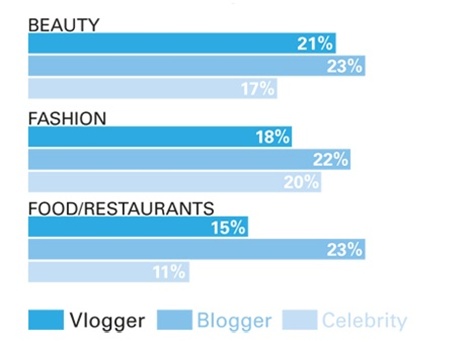
For each of the following groups of products, which person or entity would you look to for trusted advice when purchasing the product?
Judging by the recent spate of high-profile celebrity signings by Topshop (Cara Delevingne)[1] , Ritz (One Direction) and Puma (Usain Bolt)[2] , there is no lack of appetite among marketers for celebrity endorsement. However, brands are realising they need to be more creative in how they use these personalities.
To mark the launch of its new XE model, car maker Jaguar has enlisted singer Emeli Sandé (see main image above), actor Idris Elba and designer Stella McCartney to ramp up interest from a new audience in what global PR director Richard Agnew describes as the brand’s “most attainable” car, with prices likely to start at just under £30,000.
As part of the FeelXE campaign, Emeli Sandé has been collaborating with her fans over the past month to write a song that she will perform for the first time on 8 September, when the car is unveiled.
“The people we have chosen are all genuinely interested in cars and are big advocates for all things British,” says Agnew. “But as with anything it’s all in the execution. If content is authentic and genuinely interesting, whether or not a celebrity is involved, consumers won’t get bored of it.”
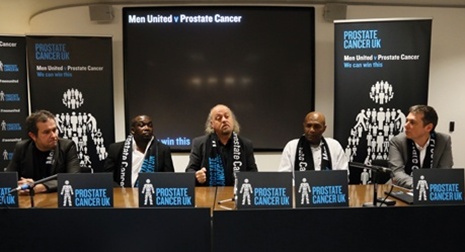
Vivienne Francis, director of communications at Prostate Cancer UK, knows that celebrity alone will not guarantee success
Vivienne Francis, director of communications at Prostate Cancer UK, does not believe there is any reason why charities should not partner with carefully selected celebrities, especially as its Men United v Prostate Cancer campaign starring comedian Bill Bailey has garnered the support of almost 200,000 men. However, she knows that celebrity alone will not guarantee success and urges any charity looking to partner with a star to have a clear strategy in place.
“Celebrity-fronted campaigns can be effective, but it is naive to believe a famous face is enough on its own to build credible engagement,” says Francis. “A carefully selected champion can add cut-through but the cause and call to action have to be equally, if not more, compelling in their own right.”
Well-known celebrities are not the answer for every brand, however. While audio specialist Sennheiser has used global stars such as Miley Cyrus to market its brand in the past, it is now working with 30 up-and-coming artists as part of its ‘What’s your momentum’ campaign.

Sennheiser works with up-and-coming artists such as Di Mainstone (above)
“Over the years we have decided that it’s not right for us to choose an artist simply because they are the biggest selling or most famous because it limits us to attracting only a certain demographic,” says Steve Dalton, director of marketing at Sennheiser.
“Sennheiser appeals to so many different consumers and people in the music industry at large, so if we were to align with one star, there’s a chance we could alienate ourselves against a huge proportion of our buying customers.”
Finding a personality that consumers can really connect with is also one of the reasons why more brands are looking to partner with online celebrities such as bloggers. With 30 million subscribers, Swedish YouTube star PewDiePie has a wider reach than many established celebrities offering their endorsements to brands. He has recently posted promotional videos on his account for Warner Bros film As Above, So Below, while Disney-owned Maker Studios has developed a mobile app for him.
UK bloggers Zoella, Bip Ling and Stuart Ashen, have also cultivated close-knit communities of fans who hang on their every word.
Zoella, who started her fashion and beauty YouTube channel in 2009 and has 5.6 million subscribers, became the first vlogger to star on the cover of a national fashion magazine when she featured in the April issue of Company. As a result, traffic to the magazine’s website increased 98 per cent, while an image of Zoella on-set became the most liked picture on Company’s Instagram page within a day, highlighting her immense pulling power.
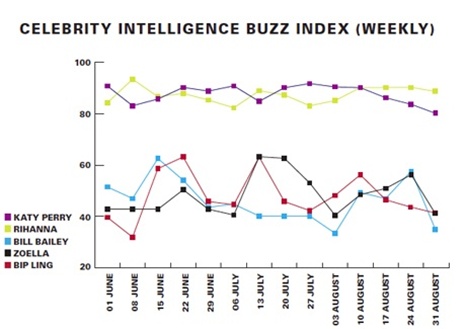
While pop stars Katy Perry and Rihanna are a class apart, bloggers Zoella and Bip Ling generate similar buzz to comedian Bill Bailey
Editor Victoria White says: “Zoella is a new type of celebrity – a touchable, achievable success story but one that has its basis in hard work and perseverance. Our readers love Zoella and her quirky YouTube channel. They love her style and views and most of all, identify with her.”
Last month, publisher Hearst announced the magazine will move to a digital-only format from October.
One-on-one communication
It is this connection and move towards a more personal, one-on-one style of communication that resonates particularly well with audiences.
“YouTubers are very genuine, authentic and easy going. While it might work in some formats to come down from above and tell audiences what to do, for vloggers it’s about engaging on the same level,” says David Benson, YouTube’s branding solutions lead for northern and central Europe.
Overall, daily viewing time on YouTube grew by 50 per cent in 2013, according to the platform, and daily subscriber numbers have risen threefold year on year. It is encouraging, too, for marketers considering a vlogger partnership that 58 per cent of UK YouTube users will tell others about a brand they love compared to just 33 per cent of non-users. This is a very engaged and receptive audience for brands that get it right.
Soft drinks brand Dr Pepper, which is owned by Coca-Cola, has taken its long-standing ‘What’s the worst that could happen?’ creative and refreshed it for the YouTube generation by teaming up with vlogger Stuart Ashen.
The 28-minute video sees Ashens, as he is better known, go in search of his lost sofa and encourages fans to interact. Since launching on 14 August the video has drummed up 500,000 views although Dr Pepper hopes to reach a potential audience of 7.5 million channel subscribers via the partnership.
Christina Lecky, Coca-Cola brand manager for north-west Europe and Nordics, says online video is now Dr Pepper’s key channel for reaching its core 16- to 24-year-old audience.
YouTube’s Benson advises any brand looking to strike up a relationship of this kind to make sure that they understand the basics of the platform first.
“Earned media is called that for a reason. YouTubers know how they talk to their fans and brands know how they want to be [positioned], so it requires co-operation. Brand managers need to have the confidence to explain what is right and wrong for their brand, but at the same time YouTubers need to explain what will and will not work with their fans,” he says.
Keep it credible
In order to maintain bloggers’ credibility, Unilever[3] senior brand manager Lauren Brooking cautions that it is also essential to make sure viewers realise a commercial agreement is in place. The Advertising Standards Authority’s chief executive Guy Parker told Marketing Week recently that the marking of vlogger posts as marketing communications is one area where the ad regulator could direct its attention in future.
Brooking says: “Viewers are very savvy and would quickly protest if they thought someone was saying something just because they are being paid.”
Brands and bloggers do need to be careful about how they manage commercial relationships since 36 per cent of people would be discouraged from reading a blog that contains paid-for content, according to a study by Research Now.
Using a celebrity won’t turn the dial on its own. If the product isn’t good, a celebrity won’t make the brand successful in the long term
Pip Brook, Vita Coco
Brands that get the balance right will reap the rewards, though, as 84 per cent of those who read blogs have bought products based on the content and one in four claim to do so on a monthly basis.
The majority of people (77 per cent) choose blogs written by someone similar to them, compared to 18 per cent who would opt for a celebrity blogger. The younger the audience, the higher the interest in celebrity, as 28 per cent of 18- to 24-year-olds would subscribe to a celebrity blogger compared to just 12 per cent of 45- to 54-year-olds.
Hind Palmer, head of European press and marketing at jewellery retailer Claire’s says teaming up with high-profile bloggers is an effective way of connecting with the sometimes hard-to-reach teen audience.
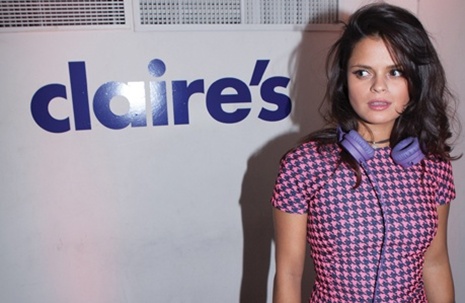
Claire’s works with both celebrity bloggers, such as Bip Ling (above), and mainstream celebrities such as Katy Perry
“Our girls look up to superstar bloggers like Zoella and Bip Ling. They see them as friends as much as idols. Social media makes them accessible and they quickly feel part of their world,” she says.
Claire’s does not limit its celebrity collaborations just to bloggers, having recently teamed up with pop star Katy Perry to launch a number of collections linked to her latest album, Prism, the latest of which launches on 8 September.
“We have different objectives for the activity we do with different people,” says Palmer. “It’s the first time Claire’s has worked with a big celebrity such as Katy Perry for a global partnership and it has been very well received by our customers. Our aim is to elevate our brand perception through the link with music, as well as to create special collections that Katy has curated.”
The focus is slightly different when working with bloggers as the brand tends to put more emphasis on short campaigns that link with particular product launches.
“These campaigns are not necessarily sales-focused. The aim is to add a cool factor to Claire’s, which often drives a new audience to stores. When we worked with British blogger Ella Catliff [author of La Petite Anglaise] and French fashion blogger Kenza Sadoun-el Glaoui [who writes La Revue de Kenza] on a shoot in Ibiza, it was more aspirational for our target audience.”
Audience reach
While Dr Pepper, Claire’s and Sainsbury’s (see below[4]) are looking to reach young audiences through their affiliation with bloggers, for Unilever it is not about appealing to a certain age group. The FMCG manufacturer launched YouTube channel All Things Hair to promote brands including Toni&Guy and Tresemmé.
Unilever’s Brooking says: “It’s about servicing a need that we feel is relevant whether you are 18 or 50. Our insight shows that there is no clear destination or real point of authority for people looking for hair inspiration but as there were 1.3 million searches just for hair in the UK [last year] there is a clear desire for one.”
The use of well-known bloggers has helped Unilever get “good visibility very quickly”, however, and she admits that when using vloggers such as Zoella and Tanya Burr in videos it does provide huge organic reach with a younger audience. Equally, bloggers such as Ruth Crilly appeal to a slightly older audience.
To date, All Things Hair has gained more than 16 million views with some of the top videos achieving over 700,000 each; the channel now has 117,000 subscribers in the UK.
Gabrielle Sander, editor of celebrity insight website Celebrity Intelligence, which is a sister brand of Marketing Week , believes it will become difficult for new bloggers to carve out a niche for themselves and receive the same level of exposure enjoyed by the trailblazers.
“When [people such as] Bip Ling first came on the scene, being a blogger was new and exciting. Suddenly, brands wanted to engage with them, have them photographed at their parties and collaborate with them on products. As a result, there has been a boom of new bloggers and vloggers hoping to reap similar success,” she says.
Sander is doubtful they will have the same longevity as more traditional stars such as Beyoncé and Brad Pitt, who remain current thanks to a continual flow of heavily-marketed albums and movies.
Claire’s Palmer agrees that some bloggers will stand the test of time and enjoy continued success but says they will need to work hard to keep up their profile because there is so much competition. And that means there will be plenty of options for marketers to choose from.
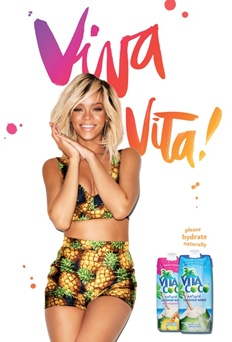
Case study: Vita Coco
Finding a genuine ambassador was key for coconut water brand Vita Coco, according to EMEA marketing director Pip Brook. Two years ago it chose Barbadian singer Rihanna.
“Rihanna has helped us to leverage the Vita Coco brand. She is a coconut water advocate and has helped us build awareness of the overall category; we now have 89 per cent market share,” says Brook.
Sales increased by 111 per cent last year and have doubled every year since launching four years ago, plus it was the fastest growing non-alcoholic beverage in the UK, according to the latest IRI data. However, Brook stresses this is not just down to the Rihanna tie-up and urges brands not to pin all their hopes on a famous face.
“Using a celebrity won’t turn the dial on its own,” she says. “It’s about getting the right balance between using celebrities and communicating the emotional and functional benefits of the product.”
Vita Coco is no longer using the singer in its marketing activity, instead choosing to focus on the product’s natural attributes in its recent ‘Grab nature by the coconuts’ campaign, but Brook says she will not rule out celebrity endorsements in the future.
There are now 47 coconut water brands available in the UK and Vita Coco predicts the category will be worth £100m by the end of the year. It recently launched its first children’s products, billing them as a “tasty yet healthy treat” (each 180ml serving contains 9g of sugar compared to the UK’s leading chilled juice drinks which have 16g).
Q&A: Simon Preece
Social media manager, Sainsbury’s
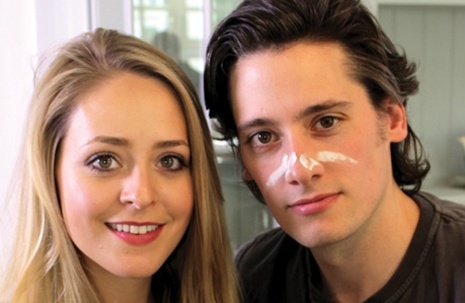
Sainsbury’s YouTube series Food with Fleur & Mike appeals to younger audiences without alienating the retailer’s more traditional segment
Marketing Week (MW): Why did Sainsbury’s choose to partner with video blogger Fleur De Force for its ‘Food with Fleur & Mike’ YouTube series?
Simon Preece (SP): Fleur De Force started her YouTube career five years ago as a beauty ‘vlogger’. In that time not only has she proved hugely popular and engaging, amassing a huge 1.7 million subscribers, but she also got married and bought a new house. Both Fleur and Mike were a great fit as presenters and really passionate about the subject.
MW: Who is Sainsbury’s target audience for the series?
SP: ‘Food with Fleur & Mike’ was created to appeal primarily to younger audiences, while still being entertaining for our traditional audience. Unlike most food content on YouTube, Fleur and Mike are not professional chefs explaining how to cook, they themselves are learning about new recipes and techniques and just like everyone else they make mistakes.
MW: How closely do you work with Fleur and Mike in choosing the topic for each episode?
SP: Fleur and Mike are critical to this process, selecting recipes based on their life events, from cooking surprise cakes for birthdays to new dishes inspired by recent travels. YouTube is a truly social platform and following every episode are genuine conversations around food in the comments section, with fans providing their own tips and making requests. The interactive nature of YouTube means it’s hugely important that this is factored into the programming.
References
- ^ Topshop (Cara Delevingne) (www.marketingweek.co.uk)
- ^ Puma (Usain Bolt) (www.marketingweek.co.uk)
- ^ Unilever (www.marketingweek.co.uk)
- ^ see below (www.marketingweek.co.uk)









